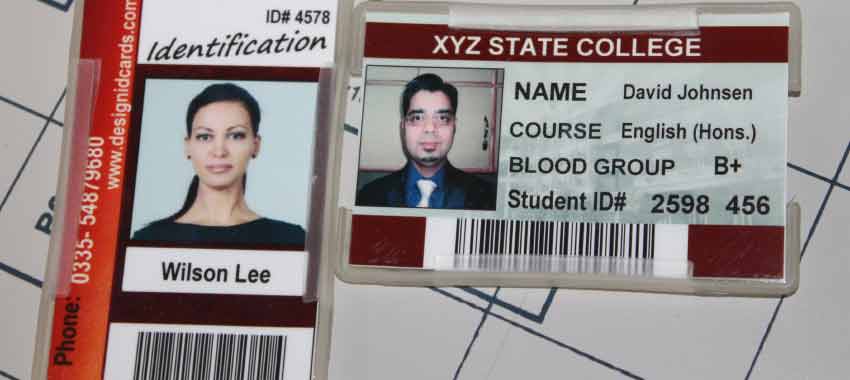-
Purpose and Branding:
Define the purpose and branding of your institution. Consider the values, mission, and unique aspects that represent your institution's identity. Incorporate these elements into your ID card design to create a visual connection between the card and the institution.
-
Professional Design Assistance:
If you lack design expertise, consider seeking help from professional designers or graphic design agencies. They can provide guidance, create visually appealing designs, and ensure your ID card design meets industry standards and best practices.
-
Accessibility:
Ensure the ID card design is accessible to all individuals. Use high contrast between text and background colors for readability. Choose font styles that are legible and easy to read for people with visual impairments. Avoid using small font sizes or intricate designs that may create difficulties for those with visual challenges.
-
Unique Graphic Elements:
Incorporate unique graphic elements that distinguish your student ID card from others. These elements could include patterns, icons, or graphics that reflect your institution's culture, landmarks, or significant symbols. However, ensure that these elements do not overcrowd the design or make the card visually confusing.
-
Logo and Colors:
Utilize your institution's logo prominently on the ID card. Ensure the logo is clear, visible, and representative of your institution's brand. Choose a color scheme that complements the logo and aligns with your institution's visual identity. Consider using colors that are distinct and not commonly associated with other institutions.
-
Security Features:
Implement security features to prevent counterfeiting and enhance the card's authenticity. These features may include holograms, watermarks, UV ink, or microprinting. Consult with a professional ID card printing company to understand the available security features and choose the ones suitable for your needs and budget.
-
Customization Options:
Consider offering customization options for students to personalize their ID cards within certain guidelines. This could include allowing students to choose a background color or upload a small image that represents their interests or hobbies. However, maintain consistency in essential elements like the institution's logo and branding.
-
Comparison and Copyright:
Conduct thorough research to ensure that your ID card design does not resemble existing designs closely. Look at ID cards from other institutions to identify any similarities and make necessary adjustments to create a distinct design. Additionally, ensure that your design does not infringe upon any copyright or trademark restrictions.
-
Card Layout:
Design a layout that is clean, organized, and user-friendly. Include essential information such as student name, photograph, and ID number. Arrange the elements logically, making it easy for people to find and read the information quickly. Use appropriate font sizes and styles for clarity.
-
Test and Feedback:
Before finalizing the design, gather feedback from various stakeholders, such as students, faculty, and staff. Conduct surveys or focus groups to understand their preferences and opinions. Incorporate constructive feedback to improve the design and ensure it resonates with the community.
Remember, creating a unique and easily identifiable student ID card design requires a careful balance between visual appeal, functionality, and security. By considering the factors mentioned above and involving the input of relevant stakeholders, you can create a design that represents your institution effectively while standing out from others.
Information Should be Included on a Student ID Card
A student ID card typically contains several key pieces of information to ensure proper identification and authentication. While the specific details may vary depending on the institution, here are the common elements that are typically included on a student ID card:

-
Name: The student's full name is an essential component of the ID card. It helps in accurately identifying the individual and distinguishing them from other students with similar names.
-
Photograph: A recent photograph of the student is prominently displayed on the ID card. The photograph should be clear and easily recognizable, enabling faculty, staff, and security personnel to verify the identity of the cardholder quickly.
-
Institution Name and Logo: The name and logo of the educational institution are typically printed on the ID card. This helps establish the affiliation of the student with the specific institution and promotes a sense of belonging and pride.
-
Unique Identification Number: Each student is assigned a unique identification number by the educational institution. This number serves as a distinct identifier and helps in differentiating one student from another. It is often displayed on the ID card in the form of a barcode, QR code, or magnetic stripe, allowing for easy scanning or swiping.
-
Issue and Expiry Dates: The ID card should indicate the date it was issued to the student. Additionally, for security purposes, it may also include an expiry date to indicate its validity. Renewal or revalidation processes can be implemented to ensure that students have up-to-date ID cards.
-
Academic Year or Enrollment Period: Some ID cards include information about the academic year or enrollment period during which the student is currently enrolled. This helps in identifying the student's status and ensures that the ID card remains relevant and updated.
-
Contact Information: In some cases, the ID card may include contact information for the educational institution, such as a phone number, email address, or website. This enables individuals who find a lost ID card to return it to the appropriate department or office.
-
Security Features: To prevent counterfeiting or unauthorized duplication, student ID cards may incorporate various security features. These can include holograms, UV printing, microprinting, signature panels, or tamper-evident elements. Such security measures help protect the integrity of the ID card and enhance its reliability as a form of identification.
-
Department or Course of Study: Depending on the institution, the student's department or major course of study may be mentioned on the ID card. This can be helpful in large institutions with multiple departments or faculties, allowing faculty and staff members to quickly identify the student's field of study.
Note:- It is important to note that while student ID cards contain personal information, steps should be taken to ensure the privacy and security of the cardholders. Institutions should implement appropriate policies and procedures to handle and store student data in compliance with privacy regulations and best practices.
Date: 07/07/2023
